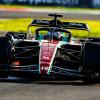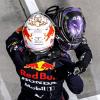Ah OK, so your process involves subjectivity. That's fine. My suggestion is using a very basic statistical method that's the same for everybody, with the only chance of variation being what I deem a 'competive laptime in the same session' to be, but it shouldn't affect the results too much. Others seem to appreciate this method; fine if you don't. But when looking at trends in any sets of data, medians are an accepted means of doing it (no pun intended).
LOL, "subjectivity" coming from a fan who chooses to randomly delete the 3 best quali's of drivers. Why not 4, or 5? Could it be because that would mean a disadvantageous outcome for your favourite driver, as representative PER-wins would be disregarded? You're sooo transparent. Thát's subjectivity at its best.
Another thing, don't try to make this about me or my process in the first place. I didn't post a list of the delta's, even though it struck me that from the get go you tried to get such a thing from me, just for the sake of arguing anyone who doesn't adhere to the fake half a sec gap at rb I guess.
And about the perceived subjectivity, you're funny. There's nothing subjective at all in keeping the 3 PER's quali times intact; on the other hand, it is completely arbitrary and subjective to have them disregarded. Well subjective at least, because I'm convinced it wasn't arbitrary as you seem to have a narrative to tell.
Don't try to use backhand tactics like saying "Ah, OK blablabla" to insinuate I told you I was using subjective metrics. As everybody who can read, it is you utilizing illogical, subjective rules like "Hey, lets delete 75% of PERs wins" so the gap increases by 92%. I didn't omit any results you didn't omit yourself, and on top of that, you doubled them.
And cut the 'statistical crap' mantra, it won't work with me, and it's painful to watch. Just to let you know, I'm a STEM student, and if I were to use your believes about statistics that you were so kindly to share with us, and would go out in the open with it, I can guarantee you that my professors would be lobbying for the university to get me kicked out, and I'd be the laughing stock among my peers. Besides, if I were to use your 'statistics', I'd have never gotten into uni in the 1st place.
You seriously make no sense at all: "..but it shouldn't affect the results too much"
Really? I already showed that it causes the gap to grow with 92%, but keep on turning a blind eye, and repeating the same erroneous broken mantra by all means. Or are you arguing 92% isn't that much? Like I said, no sense at all.
Others appreciate your drivel? Who are those? And even if you were to find others who happen to lack the same basic knowledge as you do, what would that prove? That more people have a blind spot for analysis? That fan-ism supersedes reason? Please leave the "accepted means of doing"-mantra to those who are easily fooled. Your 'means of doing things' would have you get flunked in middle school already, let alone higher education.
I really think you might be misunderstanding my intent of this exercise.
I really really think I'm not. How could I? It says so in your OP:
I'll present my alternative. My methodology is:
- Take times from the last session both drivers set a flying lap in (to mitigate against changing conditions between Q1/Q2/Q3).
- The average laptime in 2022 was 87s, so all gaps are equalised to an 87s laptime, to try to make the gaps consistent when looking at, e.g., a dry Red Bull Ring vs a wet Singapore.
- The top and bottom 3 gaps between teammates are disregarded, to get a more median average. This should eliminate freak results / bad luck from the numbers. Thus the below is from the closest 16 races for each pairing.
The more I'm surprised to learn from you that you don't actually care for the bolded parts, because you per definition disregard the 3 top results from both drivers, regardless how they came to be. And if there were actually more than 3 "freak results", you'd not omit them. That's subjectivity right in front of you and you're deliberately choosing not to see it, and moreover, your chosen methodology doesn't fit your own stated intentions at all (while actually mine does, which is quite ironic). So it actually seems you forgot about 'your intentions' yourself.
Your assumption that 3 quali's for each driver "should" cover the freak results is simply wrong, even a 6 year old can see that, because what kind of law of nature dictates that every driver will have exactly 3 freak result wins, no more, no less? Tell that to the ALO-fans on this years' ALP-threads, or from '18 those of ALO again and RICs. I noticed you don't answer any of my (implicated) questions I asked you, and I'm still waiting for an answer why omitting Brazil was "controversial" according to you, while it literally made no difference at all as that was done by both. Again, it all makes no sense whatsoever.
If one driver is faster than the other 8 times out of 10 with no anomalies, and the other driver gets a lucky day where they are faster, then 33% of their 'wins' in that set are due to luck. So whilst to you it looks disproportionate when that data is left out of the median calculation, it its just how it is.
O this is getting better and better. Again, you're trying to attribute statements I never made, quite the opposite, to me.
And, how fitting, you made a calculation error. How can a driver that has lost 8 out of 10 times, have a win, or wins, that constitute 33% of his total wins? LOL, just stop already, it's getting really embarrassing.
I'm not the one writing long posts disparaging someone else's calculations as 'wrong' in bold letters and not offering an alternative to show why.
Yeah sure, Í'm the one disparaging calculations. Take a look again at how the conversation developed. And bold letters, really? The sole two, non-calculation BTW, instances were one to emphasize that I (eye) wouldn't set an arbitrary, subjective number of 'disregards' in advance, and another with your stated intentions, as it seemed to me you forgot about them (which has only been reinforced since your last post). And here you go again, trying to portray me in some kind of neg, this time not by putting words I never said in my mouth, but the other way around, claiming "not offering an alternative to show why". I gave you alternatives, lots of them, over and over (that's another reason for the bolded parts, everything I say or explain seems to fly right past by you), but if you choose to "disparage" or even completely ignore them, yeah, that's up to you.
And the long posts should offer you a clue about the reason why they are that long, its's because of explanations, alternatives and what not. Not really one should complain about.
I'm not saying you're wrong (or anybody else is); just I'm presenting a different way of showing it that might be a more true reflection.
You could've fooled me (well, you have then); yes, and I countered by that that might not be the case, but that didn't seem to be acceptable to you.
There's a difference between being surprised by something, and that thing being wrong. And when statistical methods are involved, there is rarely a wrong answer, unless mistakes are made in the source data..
What I really would like to happen, is for you to have a conversation with a stat prof, and for me to be a witness. How dare he flunk students, everything goes.
I'm trying to explain that the whole point of my suggested method is to eliminate subjectivity (I really don't care about the gaps between drivers - I like Checo, so why would I want to put him down?). Yes sometimes someone will have really poor luck over more events which *might* have an effect, but I don't think its the case with the Red Bull example. Given you're the only one arguing against the numbers (so far) I think it does a pretty good job for most people.
Like I said, your methodology, which is subjective to the bone, does not align with your alleged intentions. Why would you want to put him down? You tell me, but apart from the fact you almost doubled his gap to his teammate, you felt it to be necessary to very much highlight it and use wording with very much negative connotation:
Using this methodology, the teammate gaps were:
1. ALB > LAT = -0.497
2. VER > PER = -0.475
3. NOR > RIC = -0.384
4. MAG > SCH = -0.292
5. ALO > OCO = -0.264
6. BOT > ZHO = -0.250
7. GAS > TSU = -0.199
8. VET > STR = -0.152
9. HAM > RUS = -0.116
10. LEC > SAI = -0.046
The takeaways are...
- Perez is as abject in qualifying against Verstappen as Latifi is against Albon. It also means he is the outlier in that he is the only one of the top 4 worst performing qualifiers vs teammates to keep his drive for 2023.
- Leclerc is not the dominant qualifier over Sainz that many would assume, and were the closest two teammates.
- The Alpha Tauris and Aston Martins were pretty close, some might say surprisingly.
- Alonso and Hamilton aren't bad for old men.
So let me see: abject, comparison with LAT, one of the 4 'worst performers', and yet still keeping his drive, the only one of the 'worst-4'. I count around a quadruple dig. If thát's not putting someone down, nothing is. And if thát's how you talk about people you like, I'm curious about what you say about people you don't like.
And again you give reason to everyone with a brain to question whether you actually understand your own system. You talk about *might* have an effect. No, it will definitely have an effect, if one driver has more than your arbitrarily chosen cutoff of '3 best scores' freak results, unless the other driver has an equal 'freak result-delta' to counter with.
As for the rb this year not having that, untrue, but the impact isn't even that big. What ís big however, is you omitting results that weren't due to "poor luck", but perfectly normal results. So another big flaw in your used methodology to which you are simply unwilling to admit, even though I've pointed it about a dozen times now (see what I did there).
Well at least you're consistent. Again, you're using the 'nobody complains, so everybody agrees', classic false dichotomy. Nice. So if nobody disagrees with me too, everybody agrees with me disagreeing with you. This just goes on to reinforce my earlier assessment of your ability to reason.
Cheers.
And BTW, nice to know that you think Ben24 is "nobody".
Edited by eab, 23 November 2022 - 18:21.
























